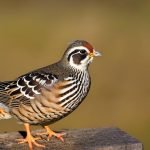Button quail, also known as Chinese painted quail, are small, ground-dwelling birds that are native to Southeast Asia. They are popular among bird enthusiasts for their small size, colorful plumage, and interesting behaviors. Button quail are often kept as pets or for breeding purposes, and they can also be found in aviaries and zoos. These birds are known for their social nature and can be kept in small groups, making them a great addition to any bird lover’s collection.
Button quail come in a variety of colors, including silver, cinnamon, and pearl, and they are known for their distinctive call, which sounds like a series of “button-like” clicks. They are active birds that enjoy foraging for food and dust bathing, and they can be quite entertaining to watch. Button quail are relatively easy to care for, making them a popular choice for both novice and experienced bird keepers. In this article, we will explore the specific requirements for keeping button quail, including their climate and habitat needs, predator protection, feeding and watering, shelter and nesting areas, as well as health and veterinary care considerations.
Key Takeaways
- Button quail are small, ground-dwelling birds that are popular for their unique appearance and low maintenance requirements.
- They thrive in warm climates and require a habitat with plenty of vegetation and hiding spots.
- Predator protection is crucial for button quail, as they are vulnerable to attacks from cats, dogs, and other small predators.
- Button quail have specific dietary needs and require access to fresh water at all times.
- Providing suitable shelter and nesting areas is essential for the well-being of button quail, as they are prone to stress in overcrowded or unsuitable living conditions.
Climate and Habitat Requirements
Button quail are native to warm, tropical climates, so it is important to provide them with a suitable environment in captivity. They require a temperature range of 70-80 degrees Fahrenheit and should be kept in a well-ventilated area with access to natural light. It is important to avoid exposing button quail to extreme temperatures or drafts, as they are sensitive to sudden changes in their environment. Additionally, button quail need a substrate that allows them to dust bathe, such as sand or fine gravel, as this is an important part of their natural behavior.
In terms of space requirements, button quail should be provided with a large enough enclosure to allow for natural behaviors such as foraging and dust bathing. A minimum of 1 square foot per bird is recommended, but more space is always better. The enclosure should also have plenty of hiding spots and areas for the birds to explore, as they are naturally curious and active. Providing a variety of perches and hiding places will help to keep button quail stimulated and happy in their environment.
Predator Protection
As ground-dwelling birds, button quail are particularly vulnerable to predators such as cats, dogs, and larger birds of prey. It is important to provide them with a secure enclosure that is predator-proof, with solid walls and a secure roof. Additionally, it is important to bury the bottom of the enclosure or use wire mesh to prevent predators from digging underneath. When housing button quail outdoors, it is important to provide them with a covered area where they can seek shelter from predators and the elements.
In addition to protecting button quail from external predators, it is also important to consider the potential for aggression within a group of birds. Button quail can be territorial and may exhibit aggressive behaviors towards each other, especially during breeding season. Providing plenty of hiding spots and visual barriers within the enclosure can help to reduce aggression and provide the birds with a sense of security. It is also important to monitor the birds closely for any signs of aggression or injury and be prepared to separate individuals if necessary.
Feeding and Watering
Button quail are omnivorous birds that require a varied diet to meet their nutritional needs. In the wild, they feed on a combination of seeds, insects, and vegetation, so it is important to provide them with a balanced diet in captivity. A high-quality game bird or finch feed can serve as the base of their diet, supplemented with fresh fruits and vegetables, as well as live insects such as mealworms or crickets. It is important to provide button quail with access to grit or small stones to aid in digestion, as well as calcium supplements to support egg production in breeding females.
In addition to a balanced diet, button quail require access to clean, fresh water at all times. It is important to provide water in a shallow dish or container that is easily accessible to the birds, as they may have difficulty reaching deep water sources. It is also important to monitor water quality and cleanliness regularly to prevent the spread of disease or parasites within the flock. Providing multiple water sources within the enclosure can help to ensure that all birds have access to water at all times.
Shelter and Nesting Areas
Button quail require access to sheltered areas within their enclosure where they can seek refuge from predators and the elements. Providing hiding spots such as dense vegetation or artificial shelters will help the birds feel secure in their environment. Additionally, it is important to provide nesting areas for breeding pairs, which can consist of small boxes or shelters filled with soft nesting material such as straw or shredded paper.
When providing shelter and nesting areas for button quail, it is important to consider the specific needs of the birds. The shelters should be small and cozy, with low ceilings and entrances that are easily accessible to the birds. It is also important to provide multiple shelters within the enclosure to prevent competition for nesting sites and allow all birds access to a suitable nesting area.
Health and Veterinary Care

Button quail are generally hardy birds that are not prone to many health issues when provided with proper care and a suitable environment. However, it is important to monitor the birds closely for any signs of illness or injury and seek veterinary care if necessary. Common health issues in button quail include respiratory infections, parasites, and injuries from aggressive behavior or environmental hazards.
In addition to regular monitoring for health issues, it is important to provide button quail with regular veterinary care, including annual check-ups and vaccinations as recommended by a qualified avian veterinarian. It is also important to establish a relationship with a veterinarian who has experience working with button quail and other small bird species, as they have specific care requirements that may differ from larger bird species.
Conclusion and Considerations
In conclusion, button quail are fascinating birds that make great additions to aviaries or as pets for bird enthusiasts. They have specific requirements for climate and habitat, predator protection, feeding and watering, shelter and nesting areas, as well as health and veterinary care considerations. By providing them with a suitable environment and meeting their specific needs, button quail can thrive in captivity and provide endless entertainment for their keepers.
When considering adding button quail to your collection, it is important to carefully consider their specific needs and ensure that you can provide them with the proper care and environment. Additionally, it is important to research local regulations regarding the keeping of button quail, as they may be subject to specific laws or regulations in some areas. With proper care and attention to their needs, button quail can be delightful additions to any bird lover’s collection.
If you’re considering keeping button quail outside, you may also be interested in learning about creating a suitable outdoor habitat for them. Check out this informative article on garden chicken coops to discover how to design a safe and comfortable outdoor space for your quail. Understanding the best coop setup for chickens can provide valuable insights into creating an ideal environment for button quail as well.
FAQs
What are button quail?
Button quail, also known as Chinese painted quail, are small ground-dwelling birds native to Southeast Asia. They are popular as pets due to their small size and colorful plumage.
Can button quail be kept outside?
Yes, button quail can be kept outside as long as they are provided with a suitable and secure outdoor enclosure. This enclosure should protect them from predators and provide them with shelter, food, and water.
What should the outdoor enclosure for button quail be like?
The outdoor enclosure for button quail should be spacious, well-ventilated, and have a secure bottom to prevent them from escaping or predators from digging in. It should also have areas for them to hide and take cover, as well as access to food and water.
What are the temperature requirements for keeping button quail outside?
Button quail are sensitive to extreme temperatures, so the outdoor enclosure should provide them with shade during hot weather and protection from cold drafts during cooler months. It’s important to monitor the temperature and make adjustments as needed to ensure their comfort and well-being.
What should button quail be fed when kept outside?
Button quail should be fed a balanced diet that includes a mixture of commercial quail feed, seeds, and fresh greens. It’s important to provide them with access to clean water at all times, especially when kept outside where they may not have access to natural water sources.
Meet Walter, the feathered-friend fanatic of Florida! Nestled in the sunshine state, Walter struts through life with his feathered companions, clucking his way to happiness. With a coop that’s fancier than a five-star hotel, he’s the Don Juan of the chicken world. When he’s not teaching his hens to do the cha-cha, you’ll find him in a heated debate with his prized rooster, Sir Clucks-a-Lot. Walter’s poultry passion is no yolk; he’s the sunny-side-up guy you never knew you needed in your flock of friends!







